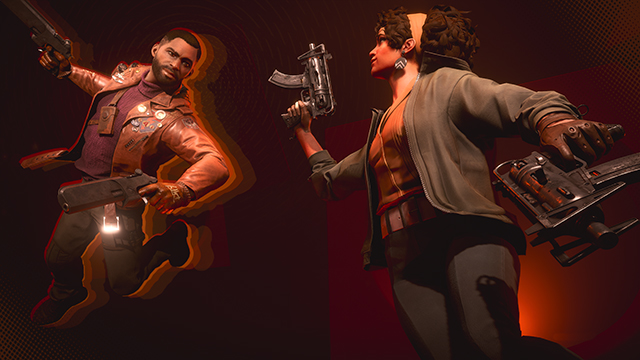Arkane Studios is known for its immersive sim games, a genre that often lets players loop around levels in any which way and come to a conclusion they see fit. But Arkane took that “looping” a bit more literally with Deathloop, a game all about a different kind of looping: time looping. This stylistic Groundhog’s Day-esque shooter has Arkane’s legendary open-ended branding on it in some ways yet is uncharacteristically limited in others.
Deathloop’s Arkane-iest features are found in its overall gameplay style. Players are given a wealth of supernatural powers and a packed arsenal of guns and are dropped in nonlinear hubs filled with various nooks and crannies. Such DNA is present in some form in all of Arkane’s titles.
Zooming in is where the differences — both good and bad — begin to reveal themselves. Deathloop makes some gestures to stealthy gameplay but is far more of a shooter, which is surprising since almost all of its powers are ripped straight from the Thief-inspired Dishonored. Using those repeated but inventive abilities in a more offensive context is refreshing, especially as Deathloop doesn’t care for nonlethal play; a limitation that doesn’t feel like one. Tossing around Eternalists — what the everlasting partygoers on Blackreef Island are referred to as — and butchering them is a power fantasy that escalates as their numbers do. Thankfully, Deathloop‘s smooth controls can keep up with its combat focus, which is an area Arkane games have struggled with in the past.
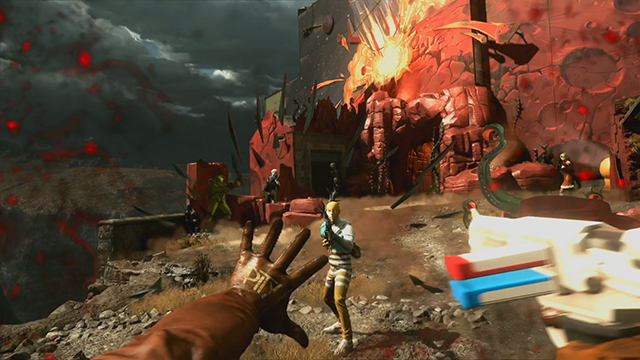
And while there is a sizable number of unique firearms and five useful abilities, the game hardly lets players loose. Just two powers can be taken into any mission and can only be swapped out upon first acquiring a power and between time periods, the former of which only happens once in the entire playthrough. Experimentation, a key pillar in the genre, isn’t as pervasive since it can’t always happen in the moment. Players either have to come back and try again on the next loop or just go another way. This restraint is especially noticeable since these powers were all in Dishonored 2, a game that always yielded full access to the protagonist’s abilities and serves as a tantalizing preview of what could have been. The comparison is too easy to make and works against Deathloop and the genre the two are founded upon since it tells players “no.”
Combat is still mostly gratifying as two powers are better than none and gunplay feels and sounds great, but the stealth is more basic. The two-power chokehold is still prevalent, however, sneaking isn’t as rewarding since the enemies are incredibly stupid and fragile. Firefights can break out mere feet from them and they won’t even turn their heads, an exaggerated expression of their general cluelessness. While one special type can call for backup, there’s only one enemy class, so they don’t require different approaches. The same methods that work for one will work for all of them and, since they only take a few hits to kill, the easy plan is often good enough. Without a proper challenge and no way to bump up the difficulty, sneaking around isn’t as engaging as it could be.
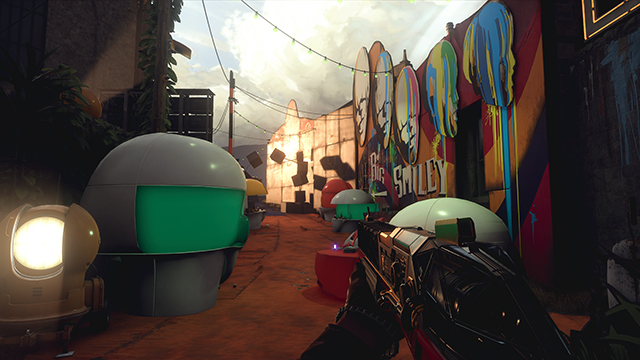
The missions also often guide the player too much, too. Arkane crafts wonderfully detailed worlds that are worth exploring and combing through. Deathloop’s four areas are smaller, but they still fall into that category and, because they are split up, are more digestible. Searching around worlds to complete objectives is naturally immersive, but the game, by default, loves to slap markers on the important bits.
Stumbling upon one of the targets is more tense if it happens organically since adapting to the unexpected is such a key aspect of this genre. And beelining toward the marker on the map is anticlimactic so it’s puzzling why this is on by default. It’s as if Arkane doesn’t want players absorbing its intricately created setting, learning the maps, and searching for the optional bits of lore or special ways to kill targets (which are already painfully scarce and, at times, obtuse). The game is at its best when all of those aspects work together. This option can (and should) be turned off, as it puts blinders on players and robs them of the joy of discovery and the urge to keep poking around.
Discovery is also crucial to the campaign’s mission structure. There are four maps, four times of day, and seven important Visionaries to murder and since there aren’t enough hours in the day to assassinate them all separately, players have to cleverly herd them around in order to kill them all before the day loops. This involves grabbing items or intel that can coercively corral these cows into the slaughterhouse.
It’s a wickedly inventive narrative structure that unfolds like a gigantic puzzle as players line up the dominoes so they may fall in one fell swoop. Learning one piece of information in one area can yield info on another section of the island and this nonlinear approach takes full advantage of the looping concept at the game’s core. Deathloop does only have one way to “perfectly” line up all of the targets and it does spell out how these pieces fit together, both of which are disappointing, but it is still a clever setup for a story.
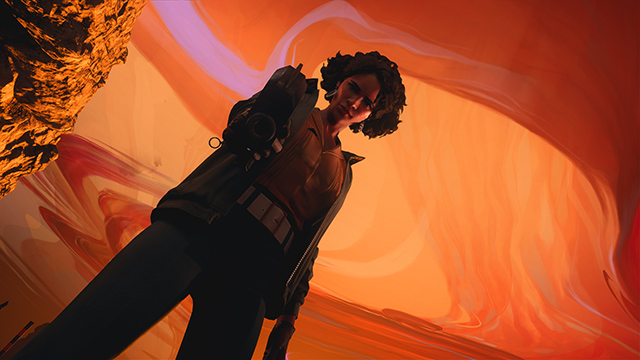
Protagonist Colt Vahn’s personal story intertwines with this overarching plot. He wakes up hungover on a beach every morning and doesn’t know why, something a mysterious woman named Julianna Blake holds over his head when she’s not trying to blast it open. She’s also the only other person who knows they’re stuck in a forever-repeating day and her role is to keep Colt from stopping the time loop.
The central mystery is significantly more entertaining due to the cat-and-mouse relationship the pair have. Dialogue is quick and witty and often hilariously delivered as they bicker back and forth before and during a mission. Jason E. Kelley and Ozioma Akagha’s performances are spectacular and even if the actual ending is disappointing and too much of the lore is locked up in optional logs, the game’s choice to focus on this outstanding duo is a good one.
The optional logs can be difficult to read because of the constant threat Julianna poses. Like Dark Souls or Arkane’s canceled game The Crossing, other players posing as Julianna can invade the campaign of those playing as Colt. It’s possible to play offline and go against a bot, but the amount of tension a real person (who can be a friend or a rando) adds makes for some of the best and most player-driven moments in the game. Real players are unpredictable and having to keep an eye out for a rogue agent adds a welcome bit of challenge to a fairly easy game that is a little lacking in emergent variables that other immersive sims have more of.
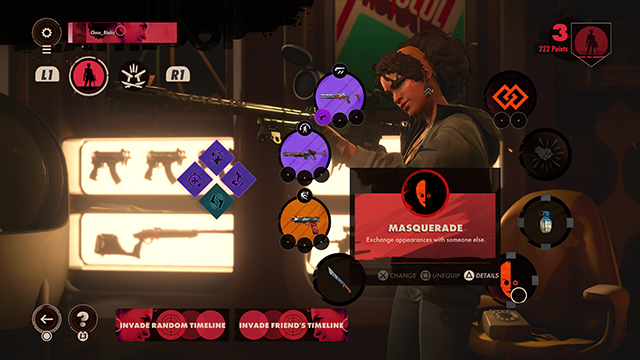
While it might sound annoying, it’s relatively well balanced. Julianna only has one life while Colt has three so it takes significantly more effort to derail someone’s campaign. This life discrepancy makes it stressful without frustration. However, it is unfair that Julianna players start at such a distinct disadvantage since it takes quite some time to unlock more powers and guns when compared to Colt. It’s a small mishap on an otherwise fascinating mode that narratively fleshes out the game’s central relationship while also providing a continuous supply of gameplay-related thrills.
Colt and Julianna personify the eccentric 1960s-era style the whole game is drenched in. From their clothing choices to their hairstyles, the two look like they were directly plucked right from that decade, as do the random Eternalists and seven other Visionaries. The color palette, retro technology, building structure, and more all properly evoke the ‘60s as well, but in a way that feels unique to this game and universe. It uses that style as a jumping-off point and filters it through Arkane’s creative lens and signature art direction. The soundtrack is also a standout as it sounds like music from the era, but is composed appropriately for the tempo the situation calls for, be it action or stealth. The game’s entire tone is rigidly consistent and undeniably original, despite its obvious influences.
Deathloop isn’t as liberating as some of Arkane’s other games and suffers a bit because of it. Only being able to take two powers into missions that initially lead players by the nose is puzzlingly restrictive, as is the underdeveloped stealth. But Deathloop is still a compelling enough shooter with a solid story hook that creatively combines its new ideas and inspirations into one unique experience, resulting in an imperfect loop, but one well worth living through a few times.
SCORE: 7.5/10
As ComingSoon’s review policy explains, a score of 7 equates to “Good.” A successful piece of entertainment that is worth checking out, but it may not appeal to everyone.
